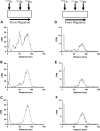Radiochemical Quality Control Methods for Radium-223 and Thorium-227 Radiotherapies
- PMID: 36149725
- PMCID: PMC9940811
- DOI: 10.1089/cbr.2022.0023
Radiochemical Quality Control Methods for Radium-223 and Thorium-227 Radiotherapies
Abstract
Background: The majority of radiopharmaceuticals for use in disease detection and targeted treatment undergo a single radioactive transition (decay) to reach a stable ground state. Complex emitters, which produce a series of daughter radionuclides, are emerging as novel radiopharmaceuticals. The need for validation of chemical and radiopurity with such agents using common quality control instrumentation is an area of active investigation. Here, we demonstrate novel methods to characterize 227Th and 223Ra. Materials and Methods: A radio-TLC scanner and a γ-counter, two common and widely accessible technologies, as well as a solid-state α-particle spectral imaging camera were evaluated for their ability to characterize and distinguish 227Th and 223Ra. We verified these results through purity evaluation of a novel 227Th-labeled protein construct. Results: The γ-counter and α-camera distinguished 227Th from 223Ra, enabling rapid and quantitative determination of radionuclidic purity. The radio-TLC showed limited ability to describe purity, although use under α-particle-specific settings enhanced resolution. All three methods were able to distinguish a pure from impure 227Th-labeled protein. Conclusions: The presented quality control evaluation for 227Th and 223Ra on three different instruments can be applied to both research and clinical settings as new alpha particle therapies are developed.
Keywords: quality control; radio-thin layer chromatography; α particle therapy; γ counter.
Conflict of interest statement
There are no existing financial conflicts.
Figures







Similar articles
-
Development of separation technology for the removal of radium-223 from targeted thorium conjugate formulations. Part I: purification of decayed thorium-227 on cation exchange columns.Drug Dev Ind Pharm. 2017 Feb;43(2):225-233. doi: 10.1080/03639045.2016.1234484. Epub 2016 Sep 26. Drug Dev Ind Pharm. 2017. PMID: 27628177
-
Feasibility of Thorium-227/Radium-223 Gamma-Camera Imaging During Radionuclide Therapy.Cancer Biother Radiopharm. 2020 Sep;35(7):540-548. doi: 10.1089/cbr.2019.3516. Epub 2020 Jun 2. Cancer Biother Radiopharm. 2020. PMID: 32486837
-
Development of separation technology for the removal of radium-223 from decayed thorium-227 in drug formulations. Material screening and method development.Drug Dev Ind Pharm. 2016 Aug;42(8):1215-24. doi: 10.3109/03639045.2015.1118494. Epub 2015 Dec 7. Drug Dev Ind Pharm. 2016. PMID: 26569601
-
Targeted Alpha Therapy with Thorium-227.Cancer Biother Radiopharm. 2020 Aug;35(6):437-445. doi: 10.1089/cbr.2019.3105. Epub 2020 Jan 20. Cancer Biother Radiopharm. 2020. PMID: 31967907 Review.
-
Progress in Targeted Alpha-Particle Therapy. What We Learned about Recoils Release from In Vivo Generators.Molecules. 2018 Mar 5;23(3):581. doi: 10.3390/molecules23030581. Molecules. 2018. PMID: 29510568 Free PMC article. Review.
Cited by
-
Evaluation of Candidate Theranostics for 227Th/89Zr Paired Radioimmunotherapy of Lymphoma.J Nucl Med. 2023 Jul;64(7):1062-1068. doi: 10.2967/jnumed.122.264979. Epub 2023 May 4. J Nucl Med. 2023. PMID: 37142300 Free PMC article.
-
SPLUNC1 regulates LPS-induced progression of nasopharyngeal carcinoma and proliferation of myeloid-derived suppressor cells.Med Oncol. 2022 Sep 29;39(12):214. doi: 10.1007/s12032-022-01816-7. Med Oncol. 2022. PMID: 36175598
-
Beyond Average: α-Particle Distribution and Dose Heterogeneity in Bone Metastatic Prostate Cancer.J Nucl Med. 2024 Feb 1;65(2):245-251. doi: 10.2967/jnumed.123.266571. J Nucl Med. 2024. PMID: 38124163 Free PMC article.
References
MeSH terms
Substances
Grants and funding
LinkOut - more resources
Full Text Sources

